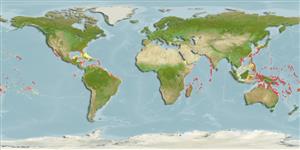Trichoplax adhaerens Schulze, 1883
| Native range | All suitable habitat | Point map | Year 2050 |

|
| This map was computer-generated and has not yet been reviewed. |
| Trichoplax adhaerens AquaMaps Data sources: GBIF OBIS |
Upload your photos
Google image |
No photo available for this species.No drawings available for Trichoplacidae.
Google image |
No photo available for this species.
Classification / Names Common names | Synonyms | CoL | ITIS | WoRMS
Not assigned | Not assigned | Trichoplacidae
Environment: milieu / climate zone / depth range / distribution range Ecology
Benthic. Tropical
Distribution Countries | FAO areas | Ecosystems | Occurrences | Introductions
Circumglobal.
Length at first maturity / Size / Weight / Age
Maturity: Lm ? range ? - ? cm
Short description Morphology
Flat (up to 0.5mm in its longest dimension), multicellular, amorphous, mobile flagellated animal lacking body cavity, digestive and nervous systems, composed of 2 layers of epithelial cells. Associated glandular cells apparently secrete digestive enzymes beneath the animal as it sits atop the algae and protozoans on which it apparently feeds; digestion seems to be entirely extracellular , as there is no mouth and no sign of phagocytosis. The much thinner, upper layer of the animal bears flagellated cells, but no gland cells. In a sense, the upper layer is ectodermal, while the lower layer, because of its involvement in digesting food and absorbing nutrients, is endodermal. Between the upper and lower cell layers is a fluid-filled space containing a dense network of fibrous cells that may be contractile (Ref. 53).
Life cycle and mating behavior Maturity | Reproduction | Spawning | Eggs | Fecundity | Larvae
Reproduces asexually, binary fission, budding (Ref. 60), fragmentation (Ref. 53). Older cultures at high density begin to produce small motile presumptive sperm cells, and as individual animals disintegrate, they spew out ova (Refs. 59, 61).
Main reference
References | Coordinator | Collaborators
Collins, A.G. 2000. (Ref. 60)
IUCN Red List Status (Ref. 130435: Version 2024-1)
CITES status (Ref. 108899)
Not Evaluated
CMS (Ref. 116361)
Not Evaluated
Threat to humans
Harmless
Human uses
| FishSource |
Tools
More information
Trophic Ecology
Ecology
Population dynamics
Growth
Age/Size
Length-weight
Length-length
Length-frequencies
Mass conversion
Recruitment
Abundance
Age/Size
Length-weight
Length-length
Length-frequencies
Mass conversion
Recruitment
Abundance
Life cycle
Distribution
Human Related
Aquaculture profile
Stamps, Coins Misc.
Stamps, Coins Misc.
Outreach
Taxonomy
References
Internet sources
BHL | BOLD Systems | CISTI | DiscoverLife | FAO(Publication : search) | Fishipedia | GenBank (genome, nucleotide) | GloBI | Gomexsi | Google Books | Google Scholar | Google | PubMed | Tree of Life | Wikipedia (Go, Search) | Zoological Record
Estimates based on models
Price category
(Ref. 80766):
Unknown.


